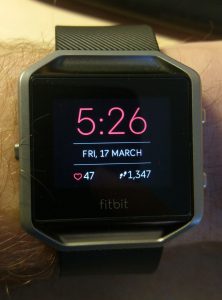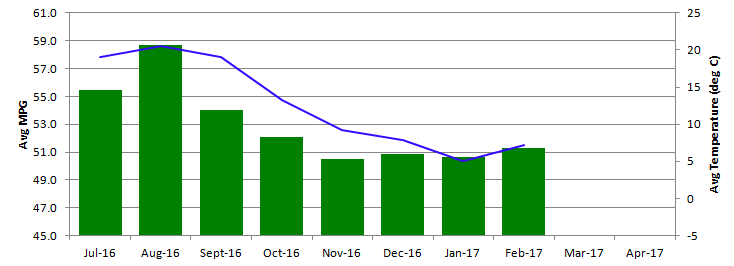 After a recent health issue I decided it was time to get myself a Fitbit to help me get into shape. I decided on the Fitbit Blaze which combines a smart watch and a fitness watch into one tiny device. I have to say for £140 it’s a very capable device and seems to work very well.
After a recent health issue I decided it was time to get myself a Fitbit to help me get into shape. I decided on the Fitbit Blaze which combines a smart watch and a fitness watch into one tiny device. I have to say for £140 it’s a very capable device and seems to work very well.
Its main feature is a heartrate monitor and step counter, but it also includes a pressure sensor so it can tell when you have gone up and down stairs for example.
It tracks heart rate 24 hours a day and uploads this via your phone to Fitbit. It does this at 5 second intervals except when you’re exercising. Using this it is able to estimate how many calories you have been burning during your activities.
It can also monitor your sleep to determine how well you slept and for how long. I can say that it does work with some degree of accuracy as I do occasionally get up to use the toilet and it at least records this reliably.
Although I have not yet put it through its paces with any proper exercise, I hope to do so soon. One of the features which I bought it for was reminders to move regularly which will come in handy given I have a desk job. This should prevent me from sitting down for long periods of time (at least that’s the theory!).
Battery life is quoted to be about 5 days. Having had it for just a few days and only charged it once, I can say this is a likely length of time if not a day less than quoted.
Smartphone notifications are I would say adequate but nothing special. If you receive a message it displays on the screen a snippet of the message. This applies to e-mails, instant messengers, etc. too. Each can be turned on and off in the app settings. Phone calls also come through but are delayed a little if you turn off ‘always on’ connectivity, which I have because it drains my phone battery like crazy.
The Fitbit uses Bluetooth 4.0 LE (low energy) to minimise battery consumption. This is good but reduces the range of the bluetooth signal to about 10ft. Perfect if you carry your phone but otherwise you will definitely miss notifications from the other side of the room. That’s not a big thing for me since my phone is usually with me anyway.
I’ll probably write a more detailed review as I use it more, but so far I’m enjoying the data it’s giving me.
I wrote a post in the past about how cold temperature affects hybrid vehicle economy. Now that it’s turning to spring and the temperature is beginning to increase, there has been a noticeable change in direction on my MPG vs temperature graphs.

Though it’s not a lot, the change is there, and it’s felt noticeably warmer too. I’ll continue to keep this data recorded and continue to update here.
I suppose the takeaway from this so far is that colder weather does negatively affect the MPG due to the engine needing to run more often, and that combined with running richer when colder means that more fuel is used overall.
I guess the solution to this problem could come in many forms (if we’re talking about keeping the ICE alive and not going EV):-
Additional engine heating – The engine is very thermally efficient, which means it takes longer to heat up. This efficiency is only good however when the engine is already warm, otherwise the engine has to run rich (use more fuel) until it is warmed up. It would be interesting to see if adding electrical heating that runs from the hybrid system to heat up the oil and coolant would significantly improve efficiency for shorter journeys, by getting those fluids and the engine up to temperature quicker. While it would of course use more energy, would this be offset by getting it up to its efficient operating range quicker? In winter it might well do, but at the expense of additional hardware. It might not pay for itself over the lifetime of the vehicle.
Bigger battery and electric cabin heating – If the battery were higher in capacity then it would be possible to use electric for cabin heating, either through resistive heating or a heat pump (more efficient than resistive in many cases), thus allowing the engine to stop when it’s viable to do so. I believe this can happen at above 50*c coolant and oil temperature. This means that all heating could go into the engine coolant and oil, it will work a little harder to generate electricity for the cabin heating, which also adds heat into the engine for the additional load. Perhaps this is all a little excessive for the gain? I’m sure Toyota/Lexus did the math on that one! However I do know that heat pump heating on EV’s is significantly more efficient than resistive in a lot of climates, so it probably wouldn’t hurt to add that to hybrid vehicles to supplement the cabin heating in cold weather. After all it’s just a modification to the A/C system…
No doubt my ideas were thought of and dismissed for cost reasons by Toyota but I’ve not read anything about either anywhere to date, so who knows!
 After a recent health issue I decided it was time to get myself a Fitbit to help me get into shape. I decided on the Fitbit Blaze which combines a smart watch and a fitness watch into one tiny device. I have to say for £140 it’s a very capable device and seems to work very well.
After a recent health issue I decided it was time to get myself a Fitbit to help me get into shape. I decided on the Fitbit Blaze which combines a smart watch and a fitness watch into one tiny device. I have to say for £140 it’s a very capable device and seems to work very well.
